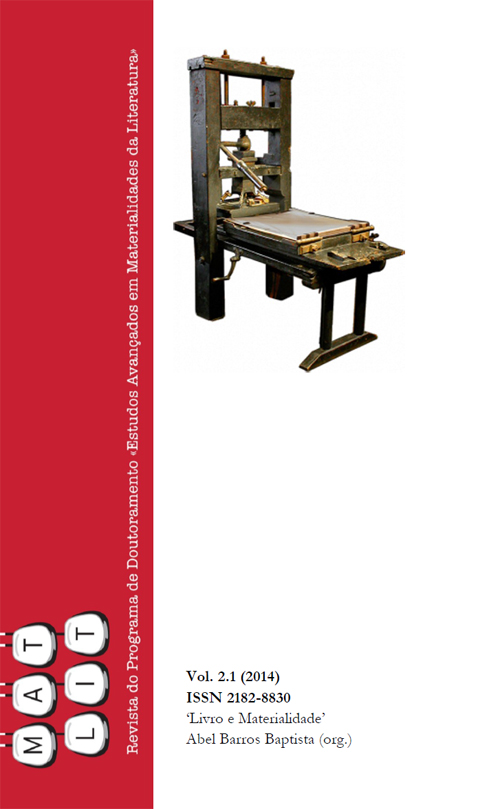Reading and Not-Printing: Obstruction at the Crater Press
DOI:
https://doi.org/10.14195/2182-8830_2-1_2Palabras clave:
Printing, American Literature, Contemporary British Poetry, Letterpress, Benjamin Franklin, Walt Whitman, Emily DickinsonResumen
I will begin this paper with a brief and partial history of American printing, detecting a shared predilection for a noticeably maverick relation to the printed page in the works (printed and otherwise) of Samuel Keimer and Benjamin Franklin during the colonial period, and the works of Walt Whitman, Emily Dickinson and Mark Twain in the nineteenth-century. I term the interrupted, dialectical printing that connects all of these writer/printers ‘not-printing’, and offer some explanation of his term and a description of some of its manifestations. I will then move on to consider how the idea of ‘not-printing’ might be helpful for the consideration of some contemporary British and American poets and printers before concluding with a description of some of the ways that the productive constraints of such a practice have influenced my own work as editor and printer at the Crater Press.
Descargas
Citas
ADORNO, Theodor (1997). Aesthetic Theory. Trans. Robert Hullot-Kentor. London: Continuum.
BERNES, Jasper; Joshua Clover, and Juliana Spahr (2014). “The Self-Abolition of the Poet.” Jacket 2, Jan 2014. 9 Sep. 2014.
https://jacket2.org/commentary/self-abolition-poet
CHIVERS, Tom (2012). “The White Review: Make, Write, Argue, Dream.” This Is Yogic. n. d. 30 Mar. 2014.
http://thisisyogic.wordpress.com/2012/03/21/the-white-review/.
CRANGLE, Sara (2012). gimme your hands. Brighton: Crater Press.
DAVENPORT, Guy (1996). “Introduction.” Paul Metcalf, Collected Works: Volume I: 1956-1976. Minneapolis: Coffee House Press.
DICKINSON, Emily (1976). The Complete Poems of Emily Dickinson. Ed. Thomas H. Johnson. London: Faber.
DICKINSON, Emily (1924). The Complete Poems of Emily Dickinson. Ed. Thomas Wentworth Higginson. Boston: Little, Brown and Company.
FRANKLIN, Benjamin (1986). Benjamin Franklin’s Autobiography. Eds. J.A. Leo Lemay and P.M. Zail. New York: Norton.
HAMPSON, Robert (2010). Speech from Michael Marks Poetry Awards.
HILSON, Jeff (2012). from Organ Music: An Anti-Masque Not for Dancing. Mataró: Crater Press.
HOWE, Daniel Walker (2007). What Hath God Wrought: The Transformation of America, 1815-1848. Oxford: Oxford University Press.
IRVING, Washington (1978). History, Tales and Sketches. New York: Library of America.
JARVIS, Simon (1998). Adorno: A Critical Introduction. Cambridge: Polity Press.
KEROUAC, Jack (2000). On the Road. London: Penguin.
KINDELLAN, Michael (2010). Crater 1. Brighton: Crater Press.
LEVIN, Harry (1960). “What Was Modernism?” The Massachusetts Review, 1.4: 609-630.
MORAIS, Henry Samuel (1894). The Jews of Philadelphia. Philadelphia: The Levytype Company.
OWENS, Richard (2013). Turncoat. Brighton: Crater Press.
PARKER, Richard, ed. (2009). Crater 0. Brighton: Crater Press.
POWERS, Ron (2006). Mark Twain: A Life. New York: Free Press.
READE, Orlando (2012). “Notes on an Unfamiliar Poetry.” The White Review, nº 4.
SUTHERLAND, Keston (23/03/2012). “UK poetry PLC / Battle of Wapping.” UKPoetry List. E-mail.
Descargas
Publicado
Cómo citar
Número
Sección
Licencia
MATLIT oferece acesso aberto integral a todos os números. Os autores que publicam nesta revista concordam com os princípios seguintes:
- Os autores mantêm a posse do copyright e concedem à revista o direito de fazer a primeira publicação do seu trabalho nos termos de uma licença Creative Commons Attribution 4.0 International (CC BY 4.0), que permite a terceiros partilharem o trabalho com a condição de atribuição de autoria e de referência à publicação inicial nesta revista.
- Os autores podem fazer contratos adicionais para a distribuição não-exclusiva da versão do trabalho publicada pela revista (por exemplo, publicá-la num repositório institucional ou num livro), com a condição de referirem a publicação inicial nesta revista.
- É permitido aos autores publicarem o seu trabalho em linha (por exemplo, em repositórios institucionais ou no seu próprio sítio web) antes e durante o processo de arbitragem, já que isso proporciona interações produtivas, assim como a possibilidade de citações mais cedo e em maior quantidade do artigo publicado (Ver The Effect of Open Access).
- Uma licença CC em formato legível por máquina encontra-se inserida em todos os artigos publicados pela MATLIT.
MATLIT embraces online publishing and open access to all issues. Authors who publish with this journal agree to the following terms:
- Authors retain copyright and grant the journal right of first publication with the work simultaneously licensed under a Creative Commons Attribution 4.0 International (CC BY 4.0), that allows others to share the work with an acknowledgement of the work's authorship and initial publication in this journal.
- Authors are able to enter into separate, additional contractual arrangements for the non-exclusive distribution of the journal's published version of the work (e.g., post it to an institutional repository or publish it in a book), with an acknowledgement of its initial publication in this journal.
- Authors are permitted and encouraged to post their work online (e.g., in institutional repositories or on their website) prior to and during the submission process, as it can lead to productive exchanges, as well as earlier and greater citation of published work (See The Effect of Open Access).
- A CC licensing information in a machine-readable format is embedded in all articles published by MATLIT.
- Attribution — You must give appropriate credit, provide a link to the license, and indicate if changes were made. You may do so in any reasonable manner, but not in any way that suggests the licensor endorses you or your use.
- No additional restrictions — You may not apply legal terms or technological measures that legally restrict others from doing anything the license permits.
Notices:
- You do not have to comply with the license for elements of the material in the public domain or where your use is permitted by an applicable exception or limitation.
- No warranties are given. The license may not give you all of the permissions necessary for your intended use. For example, other rights such as publicity, privacy, or moral rights may limit how you use the material.




